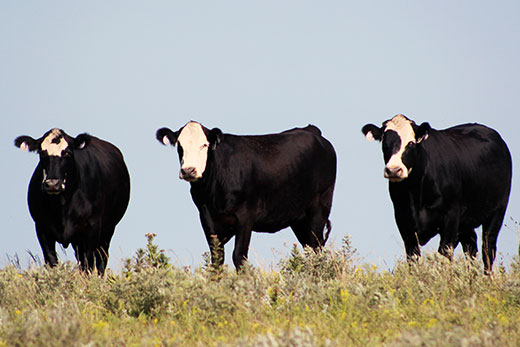
It is important to take steps now to get cows and heifers ready for the spring turnout with bulls. | Download this photo
Breeding success strategies for beef cattle
K-State beef cattle experts offer advice on ways to manage heifers and cows
April 28, 2020
MANHATTAN, Kan. – Bulls are often the focus when cattle producers are thinking about the breeding season, but experts at Kansas State University’s Beef Cattle Institute said it is important to prepare the females as well.
“Achieving a successful breeding season starts long before the cows are turned out with a bull,” said Bob Larson, Kansas State University veterinarian. “What happened last year or the year before has a big impact on how this season will go.”
Larson and his K-State colleagues recently focused on management tips for how to set up heifers and cows for breeding success during the weekly podcast, Cattle Chat.
“A good goal is to have at least 80% of those females bred in the first 45 days of season,” said Sandy Johnson, a guest on the podcast and beef cattle extension specialist with the Northwest Research and Extension Center in Colby.
To help achieve that goal, it is important to have the cows in good body condition, she said.
“To get the cows bred early you have to make sure you are managing their body condition year-round, especially from weaning through the third trimester,” Johnson said. She added that thin cows often will be delayed in resuming their estrous cycles.
K-State Research and Extension beef cattle specialist Bob Weaber said it is important to genetically match the breeding program that produces replacement females to the production environment.
“The genetic predictions that we have available in terms of growth and mature weight and milk EPD (Expected Progeny Difference, an estimate of an animal’s genetic value as a parent) are all helpful in producing cows with optimal levels of body weight and milk that fit their environment,” Weaber said.
Synchronization protocols
Whether it is cows or heifers, there is usually a mix of cycling and non-cycling females at the start of the breeding season. Johnson said a progestin (hormone) included in an estrus synchronization protocol can help induce non-cycling females to cycle.
She advised producers select an estrus synchronization protocol from the short list of recommended protocols on KSUBeef.org.
“From a management standpoint, it is easier to set up heifers in a synchronization program because oftentimes they are in a group separate from the rest of the cowherd,” Larson said.
Many of these protocols involve administering a progestin such as a CIDR (controlled internal drug release) or MGA (melengestrol acetate).
Today’s synchronization protocols allow cow-calf producers to eliminate heat detection and time artificial insemination to fit their schedule. Some producers want to capture the benefits of estrus synchronization, but still use natural service sires.
So that the bulls aren’t overworked in breeding cows, Weaber and Johnson suggested turning the bulls out with the females for five days and follow with a prostaglandin injection to trigger estrus in the unbred cycling females. Then, turn the group back out with the bulls to let them breed again. That will keep the breeding season tight without stressing the bulls.
“One of the great benefits of this protocol is that you don’t synchronize so tightly that you overwhelm your bull power. In this case, it is reasonable to plan on turning out one mature bull for every 20-25 females,” Weaber said.
Regarding heifers, the experts agreed it is important to put selection pressure on how early they conceive, meaning that heifers that conceive early bring more long-term value to the herd.
“We know heifers that get bred early are the most successful down the road — they are in the herd longer and have higher pregnancy rates,” Johnson said. “I only want to keep those that are bred early and allow others to be marketed as long yearlings in the form of stocker cattle.”
For more information about heifer breeding strategies, the experts advised referencing the Heifer CONSULT link that is shown under the tools section of the Beef Cattle Institute website.
“This online tool was developed by several beef cattle experts working together from across the country to help producers troubleshoot reproductive performance problems,” Larson said.
More information on this topic is available on the weekly BCI Cattle Chat podcast.

